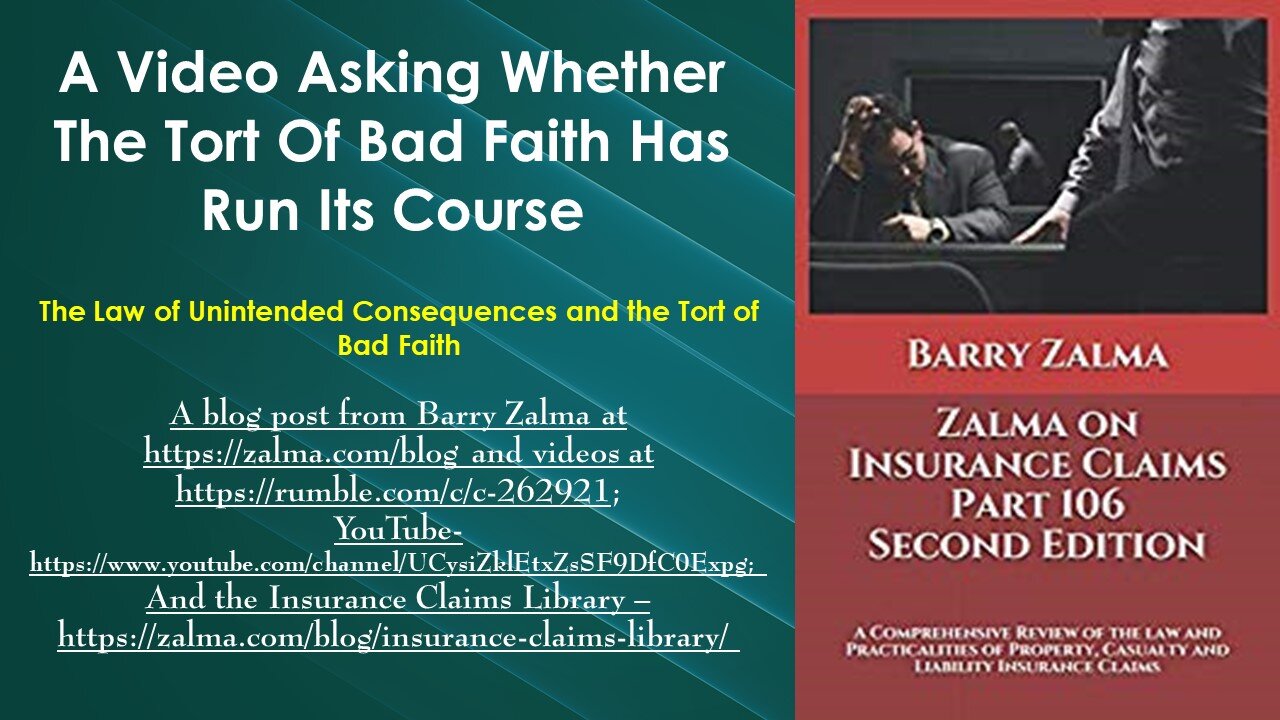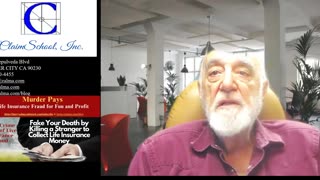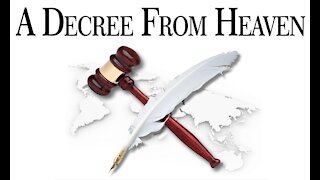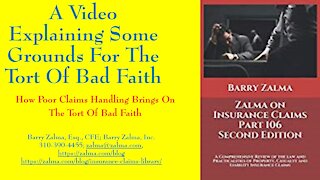Premium Only Content

A Video Asking Whether the Tort of Bad Faith Has Run Its Course
The Law of Unintended Consequences and the Tort of Bad Faith
US law was first organized using English common law. When a contract was breached, only contract damages could be recovered. Tort damages were limited to tortious conduct and the two categories of damages were mutually exclusive.
The primary purpose of damages for breach of a contract is to protect the promisee’s expectation interest in the promisor’s performance. Damages should put the plaintiff in as good a position as if the defendant had fully performed as required by the contract. Insurance, like all parts of modern society, is subject to the deprivations of the law of unintended consequences. The law can be defined as the understanding that actions of people—and especially of government or the courts—always have effects that are unanticipated or unintended. Insurance is controlled by the courts, through appellate decisions, and by governmental agencies through statute and regulation. Compliance with the appellate decisions, statutes and regulations—different in the various states—is exceedingly difficult and expensive.
Insurance contracts can be simple or exceedingly complex, depending upon the risks taken by the insurer. Regardless, insurance is only a contract whose terms are agreed to by the parties to the contract. Over the last few centuries almost every word and phrase used in insurance contracts has been interpreted and applied by one court or another. Ambiguity in contract language became certain. However, the average person saw the insurance contract as incomprehensible and impossible to understand. Ostensibly to protect the public, regulators decided to require that insurers write their policies in easy-to-read language. Because they were required to do so by law, insurers changed the words in their contracts into language that people with a fourth grade education could understand. Precise language interpreted by hundreds of years of court decisions was disposed of and replaced with imprecise, easy-to-read language.
After the creation of the tort of bad faith, if an insurer and insured disagreed on the application of the policy to the factual situation, damages were no longer limited to contract damages as in other commercial relationships. If the court found that the insurer was wrong, it could be required to pay the contract amount and damages for emotional distress, pain, suffering, punishment damages, attorney’s fees and any other damages the insured and the court could conceive.
© 2021 – Barry Zalma
Barry Zalma, Esq., CFE, now limits his practice to service as an insurance consultant specializing in insurance coverage, insurance claims handling, insurance bad faith and insurance fraud almost
equally for insurers and policyholders. He also serves as an arbitrator or mediator for insurance related disputes. He practiced law in California for more than 44 years as an insurance coverage and claims handling lawyer and more than 52 years in the insurance business. He is available at http://www.zalma.com and zalma@zalma.com.
Mr. Zalma is the first recipient of the first annual Claims Magazine/ACE Legend Award.
Over the last 53 years Barry Zalma has dedicated his life to insurance, insurance claims and the need to defeat insurance fraud. He has created the following library of books and other materials to make it possible for insurers and their claims staff to become insurance claims professionals.
Go to the podcast Zalma On Insurance at https://anchor.fm/barry-zalma; Follow Mr. Zalma on Twitter at https://twitter.com/bzalma; Go to Barry Zalma videos at Rumble.com at https://rumble.com/c/c-262921; Go to Barry Zalma on YouTube- https://www.youtube.com/channel/UCysiZklEtxZsSF9DfC0Expg; Go to the Insurance Claims Library – https://zalma.com/blog/insurance-claims-library/ Read posts from Barry Zalma at https://parler.com/profile/Zalma/posts; and the last two issues of ZIFL at https://zalma.com/zalmas-insurance-fraud-letter-2/
-
 13:02
13:02
Barry Zalma, Inc. on Insurance Law
11 months agoMurder Pays
3471 -
 13:06
13:06
JoeNicola
4 years agoVideo Blog - Faith
262 -
 6:35
6:35
Promo Videos
4 years agoSanta Stampede course video
95 -
 12:47
12:47
Promo Videos
4 years agoSnowman Stampede course video
15 -
 1:28:53
1:28:53
High Ticket Affiliate Marketer 2
3 years agoList Building Video Course
146 -
 12:16
12:16
Barry Zalma, Inc. on Insurance Law
3 years agoA Video Explaining why There is No Tort Remedy for Non-Insurance Bad Faith
134 -
 16:44
16:44
Barry Zalma, Inc. on Insurance Law
4 years agoA Video Explaining Some Grounds for the Tort of Bad Faith
134 -
 1:54
1:54
MyLordandmydad
4 years agoFirst video from Grace - My Faith
2093 -
 1:58:44
1:58:44
Film Threat
8 hours agoVERSUS: BEST & WORST OF 2024! SQUID GAME SEASON 2! JANUARY SUCKS! | Film Threat Versus
18.4K -
 18:14
18:14
Neil McCoy-Ward
11 hours agoThis Is Absolutely Outrageous!!! (The UK Gov Have Betrayed Their Citizens...)
14K12